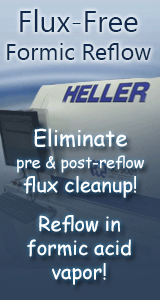| I am currently reading as many articals as I can to familiaize myself with Surface Mount Technology. My company is planning to install a SM production line by the end of the year. | Here is one of my questions. | I have read that one of the specifications for solder paste is Partical Size. Also that different particale sizes are recomended to be used on different pitch components. If This is correct, it suggests that with pitches of 0.050" use powder type 2 (45-75 microns) and with pitches of 0.025" use powder type 3 (24-45 microns). | Is this a strict rule for quality?. | If your board had components of both pitchs, what is the process, or would you just use the smaller partical size paste for all components. | All help will be welcome | Terry Terry, Good to see from you again. You are progressing down (up - to where it's really getting important) to the solder paste level and hope all is going well. Believe everything you read, then run the experiment for your specific needs. Everything is a compromise in SMT as with all else. Key factors are percent metal, solder ball size, solder ball shape (more spherical the better to minimize oxidation, enhance printing and reduce slump while getting the right amount), viscosity (primarily for consistency from lot to lot), tack time, shelf life, other ingredients (as flux composition, solids, etc.), oxidation rate over time and under what conditions, solder profile recommendations and reality, etc. For the compromise side, the major issues concern solder paste selection for what application or design (fine pitch as? or?) relative to stencil design (opening sizes and shapes), and material selection and thickness - with what print speeds and pressures, squeegee type and durometer (if rubber or plastic). Even "snap back" is still being discussed. It is just that confusing, but workable. It all comes down to soldering when all else is said and done. Do you have acceptable solder joints after you've selected the right paste, stencils, and printing equipment, applied the right paste amount at the right height and profile on the correctly designed land patterns, selected the most solderable component and PCB surfaces, placed devices accurately, and managed the soldering process and attendant profiles required to get the right joint for your customers? All these questions constantly arise in forums as this and in another you might check in on if you haven't already - the IPC Technet as an example. Now it's time for more important and informed others, living at this site, to get specific. Again, best wishes and may specified quality solder joints be with you always. Earl Moon
reply »
![]()
![]() I am currently reading as many articals as I can to famili...
- Jun 05, 1998
by
I am currently reading as many articals as I can to famili...
- Jun 05, 1998
by
![]()
![]() | I am currently reading as many articals as I can to fami...
- Jun 05, 1998
by
| I am currently reading as many articals as I can to fami...
- Jun 05, 1998
by
![]()
![]() | I am currently reading as many articals as I can to fami...
- Jun 11, 1998
by
| I am currently reading as many articals as I can to fami...
- Jun 11, 1998
by







